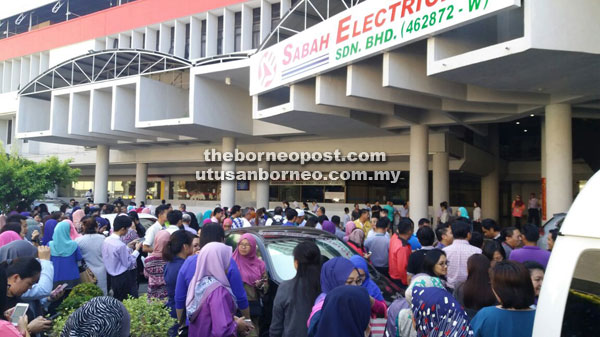
Sabah Electrical Sdn Bhd staff and members of the public gathered outside the building after it was evacuated due to the tremors.
KOTA KINABALU: Sabah is expected to experience aftershocks after it was hit by tremors following the 7.3 magnitude earthquake originating 466 kilometres northeast of Semporna in the Celebes Sea, about 2.13pm here yesterday.
Sabah Meteorological Department director Azemi Daud said the tremors would continue until the earthquake, which recorded a high reading, had become stable.
“We might experience aftershocks because the earthquake was quite sizeable, so it has to stabilise and minor tremors will happen once or twice in order for that to happen.
“I’m sure those in high-rise buildings had evacuated the premises and gathered at assembly points as a safety precaution.
“However, I think that because the location of occurrence is quite far away from us, we don’t have much to worry about,” he said.
Panic ensued in the state capital when tremors were felt yesterday afternoon.
A quick survey found that most office workers and civil servants, especially those in high-rise buildings, took precautionary measures by evacuating the premises and gathering at designated assembly areas.
In confirming the occurrence, Sabah Meteorological Department director Azemi Daud urged the public to remain calm.
“A strong earthquake had occurred at around 2pm yesterday with a magnitude of 7.3 on the Richter scale which originated from a depth of 622 kilometres in the Celebes Sea.
“It happened 466 kilometres off Semporna and tremors were felt throughout the state. However, no tsunami warnings have been issued thus far,” he said.
Azemi also believed that the possibility of a tsunami strike is unlikely.
“The depth of the earthquake this time around exceeded 100 kilometres and that is too deep for a tsunami to occur. If it had been less than 100 kilometres from sea level, then there would be a possibility.
“A depth of 622 kilometres cancels that possibility because there was no time for the energy to be released.
“Nevertheless, the tremors were felt throughout Sabah and it may have also affected the Federal Territory of Labuan,” he said.
Azemi’s statement was backed by University Malaysia Sabah (UMS) Natural Disasters Research Centre director Professor Dr Felix Tongkul, who agreed that the public should not be alarmed about a subsequent tsunami.
“This particular earthquake occurred very deep under the earth, around 600 kilometres.
“Due to the long distance nature of the earthquake, which happened around 700 kilometres from KK, we should not be too alarmed.
“This is not a local earthquake like the one that hit Ranau two years back, so we do not expect to experience severe aftershocks,” he said.
Later at 6.21pm, the Malaysian Meteorological Department issued another statement informing of another earthquake which occurred at 6.01pm in the Mariana Islands, 1,919 kilometres northeast of Bandar Tagum, Philippines and 3,069 kilometres northeast of Kinabatangan, Sabah.
The second earthquake, which recorded 5.3 on the Richter scale, also does not pose a tsunami threat.
Mount Kinabalu, which bore the brunt of the 6.0-magnitude earthquake in 2015, did not report any tremors this time.
Eighteen people were killed in the earthquakes on Mount Kinabalu. Aftershocks also continued for months, causing concern among villagers who lived at the foothills.
